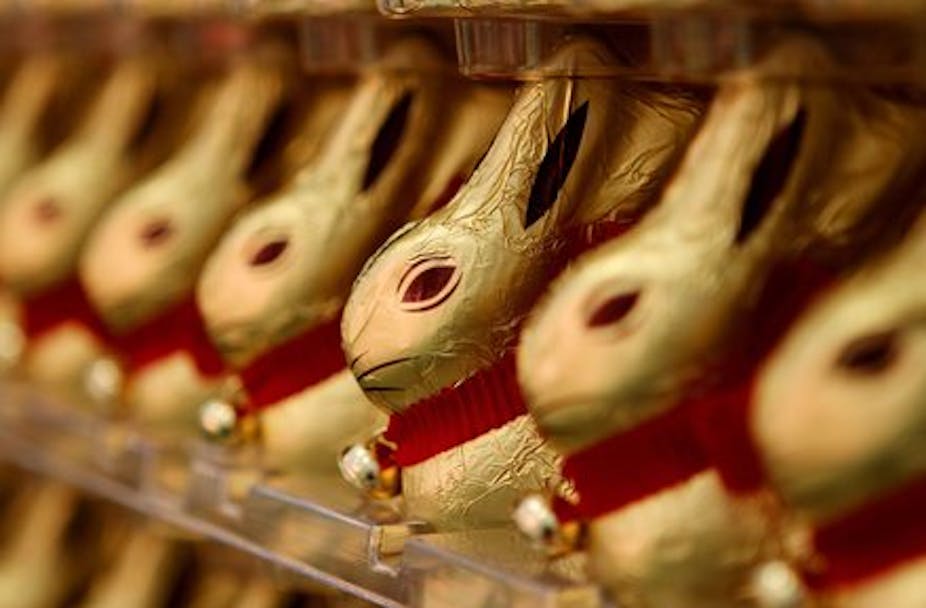At Easter, many of us enjoy chocolate eggs and other delights. The Easter bunny is still the favoured “provider” of eggs.
But for almost 20 years, researchers have been promoting an Australian icon to deliver the sweet goods: the chocolate bilby.
Why is it time to stop promoting the bunny? The simple reason is that the European wild rabbit has caused massive change to much of Australia’s landscape, devastating our primary industries and biodiversity.
Most of these changes happened between the 1860s and 1950s, and few of us have lived through any significant part of that period. This makes it difficult to appreciate their significance.
Given that this all happened long ago, does it really matter?
If we care about maintaining or recovering our native species it does. And to succeed, we have to tackle the rabbit.
Rabbits cause ongoing losses of more than $200 million each year and untold environmental damage. Around 100 million rabbits in Australia eat approximately 3 million tonnes of vegetation each year.
How did we create this problem?
Rabbits were imported to Australia in the 1850s, largely for sport. Those who introduced them had no idea that they would colonise two-thirds of the continent in 70 years.
They rapidly became severe pests, spurning 100 years of control effort. The introduction of myxomatosis in the 1950s provided the first major breakthrough, devastating rabbit populations around the country and holding them at much lower levels.
Later, effective poisoning and warren destruction techniques and co-ordinated control programs further reduced rabbit numbers.
The benefits were immediate. Wool and meat production increased by about 25%.
In some places, though, these techniques didn’t work. Where access was limited by vegetation or terrain and in the semi-arid and arid interior, myxomatosis was ineffective and mechanical control uneconomic.
New disease puts the brakes on bunnies
In 1995-96, rabbit haemorrhagic disease (RHD) was introduced,reducing rabbits to historically low population levels for over 10 years.
Unlike myxomatosis, it was highly effective in the arid interior. The agricultural benefits of RHD have been valued at over $2 billion.
RHD kept rabbit numbers low enough that many native plants regenerated. Extrapolating from numbers in the Flinders Ranges, SA, we believe RHD contributed to the growth of around 100 million shrubs per year. That probably exceeds the benefits of all other revegetation programs ever conducted in the nation by private and government agencies combined.
Vegetation recovery following RHD also produced widespread benefits for mammalian herbivores. Kangaroos, wombats and desert rodents increased.

Rabbits not beaten yet
RHD brought ten years of low rabbit numbers, and people started to think the problem was fixed. But rabbits are re-appearing in most locations and will get worse in the near future.
Even at current levels, rabbits remain the most damaging pest animal in Australia,
Research in Victoria, NSW, Qld and SA has recently shown that even one rabbit per hectare still limits regeneration prospects for native plants.
The medium- to long-term prognosis is that even at current population levels, rabbit grazing will cause ecosystem-scale changes in the Australian landscape.
This will include local extinction of plant species, irreversible changes in vegetation communities across vast areas of Australia, and loss of the fauna dependent on those vegetation communities.
There are other causes for concern. Landholders are finding it harder to conduct conventional rabbit control because they have larger properties with fewer staff to conduct labour-intensive rabbit control programs.
Government agencies are also reducing rabbit control research: they have other priorities and there hasn’t been adequate investment in relevant scientific research. This is in spite of the fact that we are already on the track of some new biocontrol agents for rabbits.
So the threats of 150 years continue and arguably become greater.
Will chocolate bilbies be enough?
The Easter bilby is playing its part in offering an alternative to the Easter bunny. It helps the community think about our landscapes: how we keep them safe for native species, for production and for recreation and inspiration. And it might make them think twice about buying a cute Easter bunny.
But unless we understand the risks of the rabbit - and support its removal - chocolate bilbies may be the only bilbies left.

